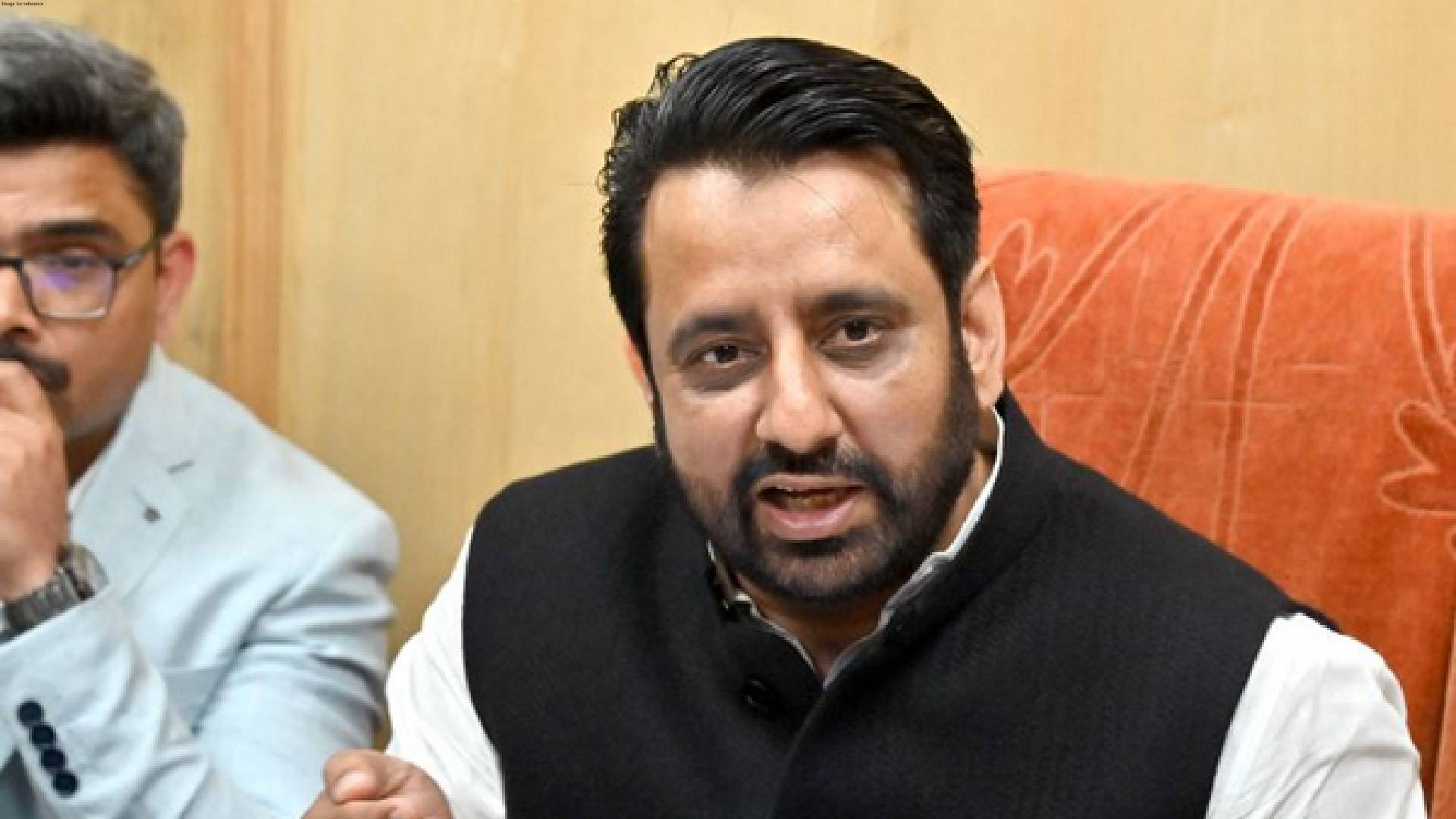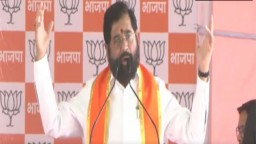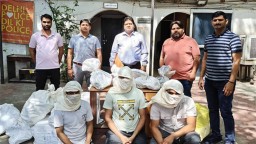Delhi Govt steps up to heighten Road Safety Standards, CM chairs review meeting

New Delhi: In a major move to improve road safety in Delhi, Chief Minister Arvind Kejriwal will now personally oversee the government's road-safety initiatives, said a press release on Tuesday.
This decision comes amid the government's bid to further improve the safety standards of the city given how many families are ruined because of road fatalities every year, said a press release, added press release. In addition to this, the Delhi government has also announced that it will be tightening the enforcement of traffic norms and taking strict action against violators. With these measures, the government aims to reduce the number of accidents on Delhi's roads and improve the safety of its citizens, the press release further added.
Chief Minister Arvind Kejriwal chaired a high-level meeting on Tuesday to review Delhi's Road Safety Standards and Initiatives. The CM took stock of various projects and proposals during the meeting including the diversion of compounding fees towards the Road Safety Fund and the setting up of safe school zones, as per the press release.
The CM reviewed road accident data in Delhi, highlighting his concerns about overspeeding on the city's roads. He also discussed the Bus Lane Initiative by the Enforcement branch of the Transport Department, road improvement projects and the strengthening of the golden hour treatment mechanism. The meeting was attended by Transport Minister Kailash Gahlot, senior officers of all concerned departments and experts from IIT Delhi, as per the statement.
The CM began the meeting with an assessment of the road accident data in Delhi. He was apprised by the officials that the government has identified that 47 per cent of the accidents take place on National and State roads whereas, this road network accounts for only 10 per cent of the city's roads, stated the statement.
As per the data, overspeeding is among the major reasons behind accidents as commuters tend to drive faster on wider roads. High-risk locations for such accidents are often road sections passing through pedestrian-heavy areas such as schools, metro stations, and commercial areas.
The Delhi Government recently conducted a study with the John Hopkins University's International Injury Prevention Unit & CSIR's Central Road Research Institute (CRRI) to study road safety practices. Under this, observational studies were carried out in 15 locations, with 225 observation sessions and 20250 minutes of observation.
The study looked upon data on helmet-wearing for two-wheelers, seatbelt-wearing for four-wheelers and speeding. As per the study, 87 per cent of motorcycle riders were observed to wear helmets, while 66 per cent of riders wear helmets correctly, overall helmet use for drivers was 92 per cent while correct helmet use was 71 per cent, for pillion riders, overall helmet use was 69 per cent, while correct helmet use was low at 46 percent.
While, 65 per cent of all motor vehicle occupants use seat belts, 85 per cent of drivers wore seat belts, 41 per cent of passengers wore seat belts, Front seat passengers had a much higher proportion of seat-belt wearing (74 per cent) than rear-seat passengers (1%), whereas there was a very low-level use of child restraints among under five-year-old children (14%), & children between 5 to 11-year-old (3 percent).
Under the speeding study, 98,294 vehicles were observed, it was found that the median speed of all vehicles is 44 km/hr, nearly 21 per cent of vehicles are overspeeding more than the prescribed vehicular limit, every second motorcycle is overspeeding, nearly half of the light trucks, cars, autos & trucks are overspeeding, Majority of cars ply within 40-50 km per hour speeds in the city and that nearly 8.5 per cent of cars, 10.2 percent of Light pickup trucks ply at speeds more than 80km/hr, majority of two-wheelers ply within 40-60 km per hour speeds in the city.
The study has resulted in three major takeaways, - first, the helmet clasping rule needs to be urgently enforced; second, seat-belts for rear seat passengers need to be enforced and children's safety needs attention; third, speed enforcement is required with urgent intervention for trucks, and light pickup trucks.
While assessing Institutional Response to Road Safety, the CM took note of the Road Safety Lead Agency that was established in 2017 with the Traffic police, PWD, Health Dept, Education Dept, and CATS. The purpose of this agency is to conduct multi-stakeholder consultation, prepare road safety plans, and review road crashes.
At the same time, the CM was presented with the details of the Rs 1 crore worth of the Road Safety Fund that was established in 2017 on the directions of the Supreme Court. The CM observed that as per guidelines the fund should also consist of 50 per cent of the compounding fees for traffic offences collected by the government, and directed the officers to immediately implement the same. The CM noted that if the compounding fees is added to the fund then the government will be able to implement its road safety initiatives better on the ground.
While reviewing Road Crash Death Reduction Targets, the CM expressed his concerns about the numbers and brought up the case of the golden hour treatment mechanism. He said that the government had introduced the Farishtey Dilli Ke scheme with the intention to strengthen the golden hour treatment mechanism which has resulted in saving thousands of lives. Such initiatives can help save more lives and prevent crash deaths, he added.
The scheme has helped provide critical treatment free of cost in around 13,000 cases in the last two years. The CM directed the officers to conduct a study on this scheme to assess its impact on the basis of how many people were given treatment in a life-and-death situation and how many were treated for ordinary injuries.
The meeting further discussed the observations of the Delhi Government's Bus Lane Marking Initiative. In April 2022, the Transport Department initiated strict enforcement of the use of bus lanes by buses & heavy vehicles. These lanes were demarcated on the extreme left side of roads to sustain mobility and ensure a hassle-free experience to commuters. Over its course of implementation, the department conducted a study with IIT Delhi in the drive to study its impact. I
In the study, it was found that often people are seen illegally parking their vehicles in Bus Lanes, slow-moving vehicles like cycles and e-rickshaws take over the space of bus lanes, and in some cases, passengers crowd the lane. All of this results in choked lanes causing buses to divert out of it, affecting traffic mobility. The department suggested two critical interventions to overcome this problem.
First, setting up of 'Zero Tolerance Corridors' on major roads like the NDMC area, Outer and Inner Ring Roads. Under this proposal, PWD will implement new bus lane markings to support the bus lane initiative, the Traffic Police will support bus lane marking by removing parked vehicles from the bus lane and MCD/NDMC will undertake encroachment removal on zero tolerance corridors. Second, redesigning of Bus Lanes.
The department has suggested redesigning bus lanes on wider roads to give way to slow-moving vehicles and free the bus lanes. Under this, a small lane will be marked on the extreme left of roads along with footpaths. This will shift bus lanes by 1-2.5m towards the right, making traffic movement more convenient and easier.
Upon this, the CM directed officers to take up the project while ensuring that the enforcement department also increases its strength of vigil along with the Delhi Police, so that the implementation is foolproof.
The department further presented its progress on Road Improvement Projects on 15 Intersections. The transport department has managed to significantly reduce traffic snarls on 15 intersections by implementing interventions like movable street furniture, junction redesign, tactical urbanism, and speed calming to ensure reduced conflict with pedestrians, passengers, and reduced delays for all road users.
Presenting before and after pictures of the Delhi Gate junction, the officers explained that with the government's efforts nearly 70 per cent of the conflict area has been reduced, there has been 33 per cent reduction in pedestrian crossing distance, 35 per cent reduction in straight going traffic distance & 33 per cent on the right turning traffic distance. Here, the government reclaimed 2500 sqm of refuge islands, medians & 2000 sqm of pedestrian crossings with no reduction in the number of traffic lanes. The officers also presented their achievements with the Mangolpuri Flyover and Neighbourhood Improvement Project in Rajendra Nagar.
The CM also reviewed the Integrated Road Accident Database (iRAD). The project was launched in March 2022 with the goal of an integrated data framework for crashes. Herein, the first point of crash entry is made by Traffic Police and subsequent data entries by the transport department, PWD and health trauma centres. This framework helps identify the reason behind road crashes and accordingly frame interventions to reduce them. The CM observed that some stakeholders were facing difficulties in uploading data to the portal as it requires dedicated manpower towards the cause.
Accordingly, the CM directed the officers to simplify the portal by reducing the required data points to make it easier for all stakeholders to address. The officers further presented their plans on the progress of Enforcement and Capacity Training along with the need for strategic communication to reduce accidents.
During the presentation, the officers also presented the roadmap for establishing Safe School Zones. 11 schools across Delhi have already been selected to codesign model safe school zones with school authorities, and students & implement interventions in community-government partnerships.
The Education Department has also established Road Safety Clubs in DOE schools. The First Safe School Zone was established at DAV, Vasant Kunj and is under construction with speed calming measures, vehicular movement plans, and safe pedestrian crossings part of student-friendly streets. The government will now be scaling up the pilot for 100 safe school zones.
The meeting further discussed several potential high-level policy interventions such as blackspot rectification through DM-led District Road Safety Committees, revisiting speed limits in the city, roll out of road safety clubs by the Education department, installation of AI Cameras at strategic locations for - Helmet use, speed enforcement in high-risk locations in non-peak hours, overloaded commercial vehicles, lane regulation and hit and run cases.
CM Arvind Kejriwal has instructed the Transport Department to prepare timelines for all its recommendations, proposals and projects under the road safety initiative. The CM further stated that he will now personally monitor the initiative by regularly meeting with the department to oversee the progress of its projects seeing how critical this initiative can prove to be in saving the lives of residents.
Issuing a statement over the initiative, CM Arvind Kejriwal said, "The safety of Delhi's citizens on the roads is a matter of utmost importance to us. Our government is committed to implementing a comprehensive approach to road safety. We aim to reduce the number of road crashes and fatalities in Delhi and ensure the safety of all commuters, especially pedestrians and vulnerable road users. We will continue to work closely with all concerned departments and experts to make Delhi's roads safer for everyone." (ANI)



.jpg)
.png)
.png)
.jpg)
.jpg)
.jpg)
.jpg)
.png)
.jpg)
.jpg)








